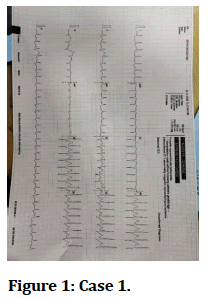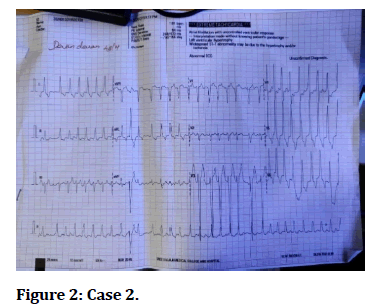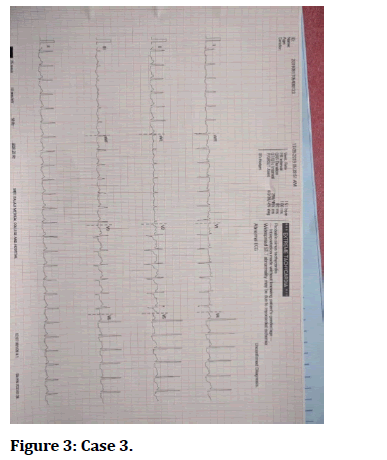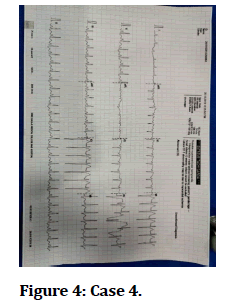Case Series - (2021) Volume 9, Issue 11
Role of Carotid Sinus Massage in Supraventricular Tachycardia-A Case Series
NN Anand*, Karthick Ramalingam, Venkat Sai Gangapatnam, Nitharsha, Arvindraj, Ram prasaanth and Likhitha Chejarla
*Correspondence: NN Anand, Department of General Medicine, Sree Balaji Medical College and Hospital, India, Email:
Abstract
Supraventricular tachycardia is a tachyarrhythmia commonly encountered in the emergency department. While multiple therapeutic modalities are available for management, use of carotid sinus massage has been questioned for its safety and effectiveness. This case series documents compilation of four cases of supraventricular tachycardia and how it was managed. Further, it highlights the role of carotid sinus massage in these patients and discusses its role in the arsenal of the physician.
Keywords
Tachycardia, Carotid sinus, Physician, Therapeutic modalities
Introduction
Paroxysmal supraventricular tachycardia is a commonly occurring tachyarrhythmia in the Emergency Department [1]. Among the treatment options available, the first-line of therapy is vagal manoeuvres, especially carotid sinus massage.
We present a compilation of case series of patients with supraventricular tachycardia who presented to the ER and the role of carotid sinus massage in the management of these patients.
Case Discussion
Case 1: A 53-year-old male presented with complaints of sudden onset of palpitations for 1 hour. No h/o chest pain or breathlessness. Patient had no history of prior comorbidities.
On examination his vitals were BP: 120/70mmHg, Heart Rate was 186 bpm. ECG was taken which showed Paroxysmal supraventricular tachycardia (Figure 1). Carotid sinus massage was performed. There was no slowing of rate.
Figure 1: Case 1.
Hence Adenosine was given 6mg IV. Patient heart rate decreased to 112bpm and improved symptomatically. Patient was referred to Cardiologist for further evaluation.
CASE 2: A 48-year-old male was brought with complaints of palpitations for 20 minutes.
Figure 2: Case 2.
Patient reported no other symptoms. H/o CAD S/P PTCA stenting 3 years ago. BP was 130/80mmHg, Heart rate was 181bpm.
ECG showed Paroxysmal supraventricular tachycardia (Figure 2). Carotid sinus massage was performed. There was no slowing of rate. Hence Adenosine was given 6mg IV followed by 12mg IV.
Patient heart rate decreased to 121bpm and he improved symptomatically. Patient was referred to Cardiologist for further management.
Case 3: A 62-year-old female presented with sudden onset palpitations for past 30 minutes. No h/o any other symptoms. No h/o prior co-morbidities. BP was 110/80mmHg, Heart rate was 151bpm. ECG was taken which showed Paroxysmal supraventricular tachycardia (Figure 3). Carotid sinus massage was performed. There was no slowing of rate. Hence Adenosine was given 6mg IV. Patient had relief of symptoms and heart rate decreased to 101 bpm. Patient was referred for 2D ECHO to Cardiologist.
Figure 3: Case 3.
Case 4: A 57-year-old male who is a k/c/o HTN on medications presented with c/o palpitations. H/o sudden onset of palpitations while at rest. No h/o chest pain/ breathlessness. No h/o sweating/ dizziness. BP was 120/90mmHg, Heart Rate was 163 bpm. ECG was showed Paroxysmal supraventricular tachycardia (Figure 4). Carotid sinus massage was performed. No response was seen. Adenosine was given 6mg IV followed by 12mg IV. Patient heart rate decreased to 108 bpm. Patient was referred to Cardiologist for further evaluation.
Figure 4: Case 4.
Discussion
The cases summarised above comprises of four patients of supraventricular tachycardia seen in Emergency department of Sree Balaji Medical College and Hospital. Only one of the four had pre-existing cardiac disease prior to presentation. And all four of them presented with the only complaint of palpitation. Extreme tachycardia was present in all four of them. After obtaining ECG, the patients underwent carotid sinus massage by the attending physician. The patient was placed in the supine position with head tilted to the opposite side. First the carotid sinus was located just below the angle of the mandible. Finger pressure with massaging motion in an upward and downward direction was then applied posteriorly and medially to compress the carotid sinus between the examiner’s fingers and the patient’s cervical vertebrae for 10 seconds. If that was unsuccessful, the carotid sinus of the opposite side was massaged in a similar manner. If the tachycardia was not converted by both methods of vagal manoeuvres, patients were managed with pharmacotherapy.
IV adenosine was given as the first choice of drug. It is administered intravenously as rapid bolus. Two of the patients reverted to normal sinus rhythm with only 6mg of Adenosine, while two patients needed 12 mg of Adenosine to revert to normal sinus rhythm. Following that, all patients were sent to the Cardiology department for 2D ECHO and further management.
This case series has been brought together to discuss the role of carotid sinus massage in patients with supraventricular tachycardia. A study done on 149 patients of SVT found only that success rate of carotid sinus massage is only 19.4%. The overall success rate of any Valsalva manoeuvre was 27.7% [2]. Another study that attempted to document the risk of complications of carotid sinus massage in SVT lists 1% risk of neurological complications (thrombo-embolic stroke by dislodgement of carotid artery thrombus) [3]. Other complications that have been reported in various reports included paraesthesia, hoarseness of voice, transient neurological deficit [2]. One patient developed ventricular tachycardia on carotid sinus massage [4].
These reports question the need for the traditional nonpharmacological therapy in SVT. The presence of efficacious drugs with a safe profile such as Adenosine which is now available in many hospitals could replace the use of carotid sinus massage altogether.
Conclusion
Although the evidence presented in this limited case series is insufficient to provide strong evidence to influence guidelines, the use of carotid sinus massage doesn’t have to be the first-line therapy anymore in emergency management of supraventricular tachycardia. The availability of other Valsalva manoeuvres and safer, effective pharmacologic options can be relied upon in these patients as first-line therapy.
References
- Collins NA, Higgins III GL. Reconsidering the effectiveness and safety of carotid sinus massage as a therapeutic intervention in patients with supraventricular tachycardia. Am J Emergency Med 2015; 33:807-9.
- Lim SH, Anantharaman V, Teo WS, et al. Comparison of treatment of supraventricular tachycardia by Valsalva maneuver and carotid sinus massage. Annals Emergency Med 1998; 31:30-35.
- Ahmed MA, Clark LM, Mardell A, et al. Termination of a long RP supraventricular tachycardia by carotid sinus massage. J Electrocardiol 2017; 50:975-7.
- Cohen MV. Ventricular fibrillation precipitated by carotid sinus pressure: case report and review of the literature. Am Heart J 1972; 84:681-686.
Author Info
NN Anand*, Karthick Ramalingam, Venkat Sai Gangapatnam, Nitharsha, Arvindraj, Ram prasaanth and Likhitha Chejarla
Department of General Medicine, Sree Balaji Medical College and Hospital, IndiaCitation: NN Anand, Karthick Ramalingam, Venkat Sai Gangapatnam, Nitharsha, Arvindraj, Ram prasaanth, Likhitha Chejarla, Role of Carotid Sinus Massage in Supraventricular Tachycardia-A Case Series, J Res Med Dent Sci, 2021, 9(11): 260-262
Received: 06-Oct-2021 Accepted: 15-Nov-2021




